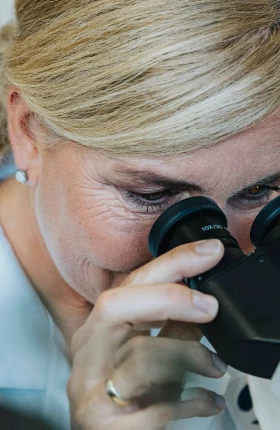If the concept is relatively simple, the science is revolutionary, and the devil is ultimately in the details of delivery. Adoptive cell transfer (ACT) technology—which includes autologous chimeric antigen receptor (CAR) T-cell cancer therapy—is one of the highest-potential fields of biopharma. ACT uses patients’ own immune cells to treat their cancer. But removing those cells from the body, genetically altering them, and returning them to the patient—safely, reliably, affordably, and quickly—is a Herculean challenge. A big part of the solution may lie not in biology or medicine but in digital technology and analytics.
A Personalized Supply Chain
Here’s the conundrum. The discovery that the genetic modification of a patient’s white blood cells can cure cancer has revolutionized care. Since the first approval by the US Food and Drug Administration of a CAR T-cell therapy in 2017, the CAR T-cell field has rapidly expanded, targeting multiple diseases using a wide array of cell types. Although only three treatments in the US and one in Europe have so far been approved, more than 400 clinical trials are underway in the US, more than 250 are progressing in Europe, and more than 300 are advancing in China. Venture capital firms have invested close to $12 billion in the past five years, strategic partnerships have provided an additional $2.2 billion of funding, and biopharma companies have laid out a total of $88 billion to acquire 15 early-stage companies with pipeline cell therapies. The industry is intent on delivering curative therapies to every patient who needs them in the next five to ten years.
But there are significant hurdles. Cell therapies’ personalized nature, which is what makes them work, creates unprecedented complexity in manufacturing and distributing them at scale. Unless these challenges can be overcome, CAR T-cell therapy is unlikely to become a mainstream solution.
So far, the large-scale adoption of CAR T-cell therapy has been limited by the complexity underpinning the entire treatment process. (See Exhibit 1.) To build a commercially successful supply chain, a biopharma company has to be able to maintain or achieve the following:
- Short and predictable turnaround times for cell removal, modification, and return
- A high manufacturing success rate
- High efficacy and safety for all patients
- An affordable treatment cost
These challenges create a set of supply chain requirements for large biopharma companies. (See Exhibit 2.) These requirements are directly at odds with the typical ones in the following areas:
- Delivery Model. CAR T-cell therapy is made to order. Manufacturing cannot begin until the patient’s cells are collected and transported to the manufacturing site.
- Patient-Derived Raw Materials. Every patient is different (in age, prior exposure to chemotherapy, and T-cell state function, for example), which affects the consistency and efficacy of the final therapy.
- Absence of Scale. Individual batch volumes for CAR T-cell therapies are very small—one per patient.
- Supply Constraints. Since projected demand levels are unclear and supply ecosystems are largely unformed, biopharma companies have to plan for a wide variety of scenarios, including capacity-constrained manufacturing and long lead times for ramping up production. Many companies must balance internal and external capabilities.
- Chain of Custody. The personalized nature of the CAR T-cell treatment mandates reliable and real-time end-to-end tracking and access to data to ensure the right patient receives the right therapy. This can be achieved only through robust systems integration involving all the key interface points (such as patient services, manufacturing, quality control, distribution, and logistics).
Potential Long-Term Solutions
Two scenarios could lead to the resolution of many of these issues, but both are largely speculative and represent long-term solutions at best. One is that technology and regulation evolve toward enabling distributed manufacturing networks, making point-of-care manufacturing a realistic possibility. This scenario would significantly alleviate the constraints related to end-to-end lead time, tracking and tracing, and overall network coordination. At the same time, however, distributed manufacturing could be costly because of demand and capacity uncertainty and the complexity of ensuring comparability across point-of-care sites.
The other possibility is the therapy’s evolution from autologous to allogeneic—from made-to-order production to cells manufactured in large batches from unrelated donor tissues. This would effectively minimize the majority of challenges faced by CAR T-cell therapy to date (except perhaps for supply constraints) and bring the scaling challenge much closer to a familiar paradigm for biopharma companies.
In the near term, however, we need to assume that the distributed nature of the supply chain and autologous nature of the therapy remains largely as it is today.
A Digital Supply Chain Prescription
Although the combination of barriers to scaling up CAR T-cell therapy may be uniquely challenging, the biopharma industry has dealt with many of the specific issues before, including the intricacies of individual supply chains. Some biopharma players with the requisite digital maturity have already started implementing segments-of-one capabilities. Biopharma companies can apply the technology used in their industry and the lessons learned by themselves and their peers, as well as the technology and lessons from other industries facing similar issues, to advance the development of CAR T-cell therapy by focusing on five priorities:
- Collaborating efficiently end to end
- Managing scheduling and volatility
- Managing demand
- Optimizing costs
- Ensuring patient safety and security
The key to addressing these five priorities is the establishment of a digital supply chain in which all the important stakeholders contribute and use data to keep track of the product, environmental conditions, and performance through each step of the treatment process. From the time when cells are removed from the patient to the time when they are returned, data is collected from sensors and transactional systems and fed into a digital twin (essentially a computer model) of the entire CAR T-cell therapy value chain. (For security and safety purposes, this twin may take the form of a decentralized data ledger using blockchain technology.)
The digital twin provides a broad variety of analytical applications that support and optimize the treatment process, including scheduling, capacity planning, and manufacturing. The resulting analytics and insights are delivered through a control tower application (not unlike the tools airlines use to track their fleets and schedules), supporting the needs of each participant and providing access to the insights for all involved.
Here’s how it works in more detail.
Collaborating Efficiently End to End. The control tower is a shared portal with user-controlled access that serves as a single source for performance data, including a wide variety of metrics and insights at a glance. It enables easy coordination among multiple stakeholders and helps mitigate risks or delays, visualize interdependencies across steps in the value chain, drive continuous improvement initiatives, and track performance.
The control tower tool enables coordination that is crucial for CAR T-cell therapy, given the large number of participants and stakeholders.
The control tower tool provides visibility into such key parts of the process as scheduling as well as raw-material flow and inventory. It tracks KPIs and lays the foundation for more cutting-edge applications, such as enhanced decision making, advanced analytics, and collaborative planning integration. This kind of coordinating function is crucial for CAR T-cell therapy, given the large number of active participants (including those in the supply chain, patient operations, quality control, and manufacturing) and other stakeholders (logistics vendors, payers, hospitals, patients, and doctors, for example).
BCG has helped biopharma companies design and construct custom control-tower applications. The applications provide visibility into and analytics for critical operations at the overall network and work-center levels, augmenting and supporting supply chain and lean production activities. Biopharma companies could apply this solution to the challenges of CAR T-cell therapy as well.
Managing Scheduling and Volatility. Managing treatment lead time—both scheduling treatments promptly and minimizing delivery time from cell removal to return—is vital. Consistency in treatment timing is also important since this allows physicians to gain more control and certainty over treatment protocols. A dynamic scheduling tool can help mitigate lead time risks, such as manufacturing delays, unplanned staff and equipment downtime, quality-release delays, safety issues, fast-changing patient conditions, and raw-material inventory challenges (all of which can be tracked by the control tower application). Such a tool also enables reprioritization of batches and prompt notification of key stakeholders (internal and external) of any expected delays to mitigate any impacts.
The ability to adapt to disruptions in real time is not a unique requirement of CAR T-cell therapy—or the biopharma industry. BCG has worked with companies in a variety of industries (including steel, chemical, automotive, and biopharma) to unlock significant value using dynamic scheduling optimizers. For example, BCG and a major international airline developed an operational performance optimizing tool that increases scheduling flexibility without affecting customer satisfaction by helping airlines adapt in real time to major disruptions such as storms, disabled aircraft, or labor shortages. For one airline, this tool identified $100 million in cost savings, a 2% to 5% reduction in flight delays, and a 3% to 8% reduction in costs related to cancellations.
Managing Demand. Unlike traditional biopharma treatments, the CAR T-cell therapy is not made to replenish stock. Instead, the supply chain starts with patients and requires advanced demand-management capabilities to synchronize patient apheresis with manufacturing capacity. A key challenge lies in the variation in initial patient attributes, which is a key determinant of the final product quality. In the future, cell therapy could use a bespoke manufacturing process that can be easily adapted to different types of patients yet achieve consistent clinical outcomes.
Demand forecasting also affects capacity planning. CAR T-cell therapy entails a number of parameters (such as clinical-trial timing, indication approval timelines, and market-driven demand variability) that lead to unclear demand signals as well as to uncertainties around capacity availability (such as the time needed to bring a facility online and the possibility of production failure). Ensuring that the necessary capacity is available at the right time, and getting that capacity in place, is a complex exercise and involves long lead times.
Simulation-based forecasting can help reduce uncertainty. Stochastic-based simulations, such as the often-used Monte Carlo technique, which projects probabilities on the basis of the statistical distribution of multiple variables, can be an effective tool in planning for a variety of outcomes. Simulating a variety of parameters helps accurately predict the probability of under- and overusing available or planned manufacturing capacity. We implemented simulation-based forecasting for a leading cell therapy company to help its management make strategic decisions related to manufacturing capacity expansion. Predictive algorithms that use machine learning to go beyond simulations are rapidly improving their ability to project the manufacturing capacity required and the timeline for achieving it.
Optimizing Costs. Whether CAR T-cell therapies will enter the mainstream of cancer treatments hinges largely on the ability of biopharma companies to drive down costs. The current treatment process and associated cost profile is not sustainable for patients, providers, or payers. While step changes in cost can be achieved only by the kind of major improvements in the delivery platform described in the previous section, in the near term, advanced analytics can deliver ongoing reductions.
The ability of companies to drive down costs will largely determine if CAR T-cell therapies enter the mainstream.
Labor is one of the main cost drivers, and companies are looking to automate their manufacturing processes while ensuring process reliability by using closed systems. These manufacturing processes put data at the forefront of manufacturing cost and productivity optimization.
We have worked with companies to develop dynamic scheduling solutions to optimize staff and equipment deployment by blending information from production, supply chain, and financial systems. These solutions unlock capacity constraints, provide visibility into the detailed drivers of cost, inform potential savings, and help reduce costs by furthering an understanding of the tradeoffs.
For example, we assisted a vaccine manufacturer tailor its production process to each batch. By developing a series of machine learning algorithms that recommended real-time adjustments on the basis of the unique characteristics of each batch, the company was able to maximize yield by more than 13%.
Ensuring Patient Safety and Security. CAR T-cell therapy is unique in its need to closely track the patient identity from apheresis through manufacturing, infusion, and long-term follow up, making sure that the right patient receives the right treatment every time. Given the fragmented data sources and the need to ensure patient confidentiality, blockchain—the same technology that, for example, can provide assurance that a diamond is conflict free—offers a tamperproof way of tracking records through a central repository. A similar approach can be employed for the CAR T-cell therapy’s track and trace requirements, leveraging digital fingerprinting of the material while allowing broad data sharing across participants of the ecosystem.
Time to Invest—Now
To successfully extract value from digital and analytics, biopharma companies need to invest early in infrastructure and tools, build a skilled workforce and digital culture, and set up an operating model that quickly translates ideas into experiments and, ultimately, solutions.
Infrastructure and Tools. Companies need to invest in infrastructure when they are still early enough in the journey that they can embed digital tools as they build their manufacturing sites (rather than having to retrofit an existing site). The kind of control tower tool described above requires investment in data collection and storage infrastructure—specifically, inline sensors and electronic systems to collect data (batch manufacturing records, for example) and a centralized, scalable, and secure repository to store and provision the data for advanced analytics.
The need for access to abundant data may present companies with another conundrum. On the one hand, development of a fast, smart, effective CAR T-cell treatment process will constitute a significant competitive advantage in this emerging therapeutic area, the value of which could be substantial in the long term. On the other hand, pooling resources among multiple players—or even on an industrywide basis—could speed development of the digital and data tools that companies need and of a CAR T-cell ecosystem that delivers benefits to all participants.
Skilled Workforce and Digital Culture. Talent that has a combination of cell therapy and digital and analytics knowledge will be at a premium. The right culture—one that breaks data silos and democratizes data for use across the organization in a centralized manner—is a prerequisite for success.
Operating Model. To harness the value of digital technologies and analytics, it is critical that companies scope initiatives across various functions and use a data-driven decision-making process to prioritize initiatives (such as reducing the time between cell removal and cell return, cutting the cost of goods sold, increasing predictability, or reducing raw material variability). Companies also need robust business processes to facilitate the cross-functional collaboration and agile deployment of good manufacturing practices for many of these initiatives.
CAR T-cell therapy has only started to deliver on its transformative promise. Much more work remains to be done to ensure that cell therapy is successful for the full potential patient population. Investing in digital and analytics is an essential early step in this journey.








